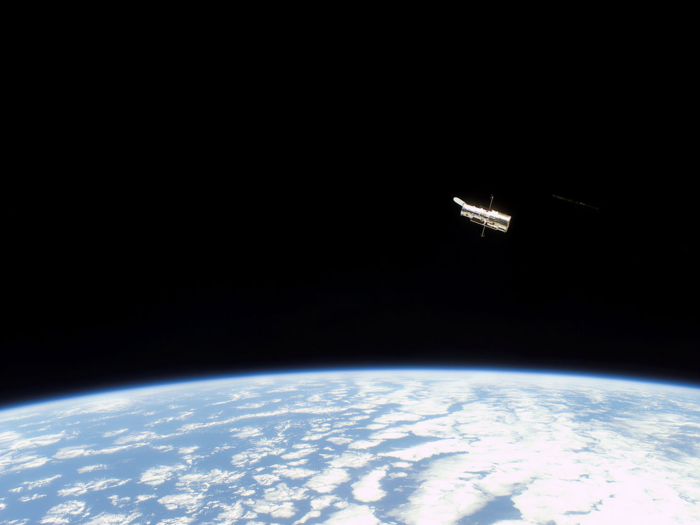
It also found that the universe is expanding more quickly than scientists imagined.



It will study how the first stars and galaxies formed, how planets are born, and where there might be life in the universe.
The upcoming telescope is fully assembled and now faces a long testing process in Northrop Grumman's California facilities before its launch date on March 30, 2021.

The farther it looks out into space, the more the telescope will look back in time, so it could even detect the first glows of the Big Bang.
JWST will also observe distant, young galaxies in detail we've never seen before.

Such imaging could help answer questions about how the galaxy and its black hole formed.
"Does the black hole come first and stars form around it? Do stars gather together and collide to form the black hole? These are questions we want to answer," Jay Anderson, a JWST scientist, said in an October press release.

By measuring the intensity of star light passing through a planet's atmosphere, the telescope could calculate the composition of that atmosphere.

But as of yet, they haven't been able to study most of those planets' atmospheres to look for signs of life, also known as "biosignatures."

Earth's atmosphere has a lot of oxygen because life has been producing it for billions of years. Oxygen isn't stable enough to last long on its own, so it must be constantly produced in order to be so abundant.
The combination of carbon dioxide and methane (like in Earth's atmosphere) is even more telling, especially if there's no carbon monoxide.
That's because carbon dioxide and methane would normally react with each other to produce new compounds. So if they exist separately, something is probably constantly producing them. That something could be a volcano, but as far as we know, only a lifeform could release that much methane without also belching out carbon monoxide.

The agency plans to launch it into Earth's orbit in the mid-2020s. Over its five-year lifetime, the space telescope will measure light from a billion galaxies and survey the inner Milky Way with the hope of finding about 2,600 new planets.

That breadth will help scientists probe questions about what the universe is made of and how it works — starting with dark matter.


The entire universe is comprised of 27% dark matter and 68% dark energy. Everything we can see and observe with scientific instruments accounts for less than 5%.


WFIRST will attempt to map the mysterious workings of dark matter and energy by measuring the universe's expansion over time.
"It will lead to a very robust and rich interpretation of the effects of dark energy and will allow us to make a definite statement about the nature of dark energy," Olivier Doré, a NASA scientist working on WFIRST, said in a press release.

Euclid will peer into deep space to see ancient light and study how the universe has evolved over the last 10 billion years. It's slated to launch in 2022.

Modern-day measurements contradict the predictions scientists have made based on the ancient past. The mismatch indicates that something big is missing from the standard model of the universe, but nobody knows what.
"Therein lies the crisis in cosmology," astrophysicist Chris Fassnacht said in an October press release.

Scheduled for completion in 2022, the LSST will measure the universe's expansion. The telescope will also chart the movements of potentially hazardous asteroids that could fly dangerously close to Earth.

At 39 meters (128 feet), it will be the largest optical telescope in the world once it's completed in 2025.


That's because the planets most likely to be habitable are usually Earth-sized, and that's very small.
"We need to wait for the next generation of instruments — the next generation of space-based and ground-based instruments — to really start to do this for properly habitable Earth-like planets," Jessie Christiansen, an exoplanet researcher at NASA, told Business Insider.


The LUVOIR proposal relies on a design similar to that of the JWST. Estimates suggest it could image 50 Earth-sized exoplanets over four years, studying their atmospheres, seasons, and even surfaces.
If chosen for funding and construction, these telescopes could launch in the 2030s.
 I spent $2,000 for 7 nights in a 179-square-foot room on one of the world's largest cruise ships. Take a look inside my cabin.
I spent $2,000 for 7 nights in a 179-square-foot room on one of the world's largest cruise ships. Take a look inside my cabin. One of the world's only 5-star airlines seems to be considering asking business-class passengers to bring their own cutlery
One of the world's only 5-star airlines seems to be considering asking business-class passengers to bring their own cutlery Vodafone Idea FPO allotment – How to check allotment, GMP and more
Vodafone Idea FPO allotment – How to check allotment, GMP and more Vodafone Idea shares jump nearly 8%
Vodafone Idea shares jump nearly 8%
 Indians can now get multiple entry Schengen visa with longer validity as EU eases norms
Indians can now get multiple entry Schengen visa with longer validity as EU eases norms
 Investing Guide: Building an aggressive portfolio with Special Situation Funds
Investing Guide: Building an aggressive portfolio with Special Situation Funds

Copyright © 2024. Times Internet Limited. All rights reserved.For reprint rights. Times Syndication Service.